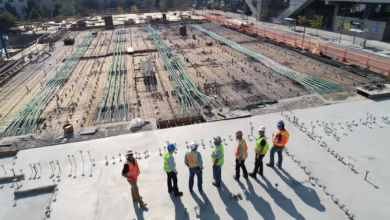Mining Regulations and Metal Markets: Navigating the Impact on Prices and Future Trends

In recent years, the mining industry has faced a transformative wave of regulations aimed at addressing environmental concerns, ensuring worker safety, and promoting sustainable practices. As governments and regulatory bodies around the world scramble to implement stricter policies, the implications for metal prices have become increasingly profound and complex. Understanding the intricate relationship between mining regulations and market dynamics is essential for investors, industry leaders, and policymakers alike. This article delves into the regulatory landscape that shapes the mining sector, examining how heightened compliance requirements can lead to price fluctuations in metal markets. Additionally, we will explore future trends and predictions regarding metal prices as these evolving regulations continue to reshape the industry. By unpacking these critical elements, we aim to provide a comprehensive overview of how the intersection of regulation and economics is influencing the global metals landscape.
- 1. **"Regulatory Landscape: Understanding the Policies Shaping the Mining Industry"**
- 2. **"Price Fluctuations: How Stricter Mining Regulations Influence Metal Markets"**
- 3. **"The Future of Metal Prices: Predictions in the Wake of Evolving Mining Regulations"**
1. **"Regulatory Landscape: Understanding the Policies Shaping the Mining Industry"**
The regulatory landscape surrounding the mining industry is complex and multifaceted, significantly influencing metal prices through a variety of mechanisms. Governments worldwide implement mining regulations to ensure sustainable practices, protect the environment, and safeguard the rights of local communities. These policies can vary greatly by country, reflecting different political, economic, and social contexts.
One of the primary components of mining regulation is the permitting process, which can impose stringent requirements on companies seeking to explore or extract minerals. These regulations often include environmental assessments, community consultations, and compliance with safety standards. As a result, the time and cost associated with obtaining necessary permits can significantly impact a mining project’s viability. Delays in permitting can lead to reduced supply in the market, which, in turn, can drive up metal prices due to scarcity.
Additionally, regulations concerning land use and mineral rights can influence the availability of exploitable resources. In regions where governments prioritize conservation or indigenous land rights, access to mining sites may be restricted, limiting production. This limitation can create supply shocks in the market, especially for metals that are already in high demand, such as copper and lithium, which are critical for technology and renewable energy sectors.
Furthermore, regulatory changes can introduce uncertainty for investors and mining companies. For instance, sudden shifts in policies—such as increased taxation, stricter environmental compliance requirements, or the introduction of export restrictions—can lead to volatility in metal prices as market participants adjust their expectations. When investors perceive that regulatory risks are rising, they may withdraw or reduce investments in certain metal markets
2. **"Price Fluctuations: How Stricter Mining Regulations Influence Metal Markets"**
Stricter mining regulations can significantly influence metal markets by introducing volatility and price fluctuations. When governments implement more stringent environmental, safety, or operational regulations, the immediate effect is often a decrease in the supply of metals. This occurs because mining companies may face increased operational costs, longer permitting processes, or even temporary shutdowns while they adjust to new compliance requirements. As supply diminishes, the basic principles of supply and demand come into play, often leading to higher metal prices.
For instance, when a major mining jurisdiction enacts stricter regulations, it can create uncertainty in the market. Investors may react by speculating on future supply constraints, driving prices up in anticipation of reduced availability. Historical examples can be seen in countries like Chile and Indonesia, where regulatory changes led to supply disruptions in copper and nickel production, respectively. These disruptions not only elevated prices but also caused ripple effects throughout global supply chains, as manufacturers and investors sought to adjust to the new market realities.
Moreover, stricter regulations can also lead to increased operational costs for mining companies. These costs can stem from the need for advanced technologies to meet environmental standards or the requirement for additional labor to ensure compliance with safety measures. As mining companies grapple with these higher expenses, they may pass on these costs to consumers in the form of higher prices, further exacerbating price fluctuations in the metal markets.
In addition to direct supply impacts, stricter mining regulations can alter investor sentiment and market dynamics. Companies that are perceived to be operating in a region with unstable regulatory environments may see their stock values decline, leading to reduced capital investment in new mining projects. This lack of investment can create a feedback loop, whereby potential future supply is diminished just as existing production is affected by regulatory compliance, pushing prices even higher.
Overall, the interplay between mining regulations and metal prices highlights the complex relationship between governance, market dynamics, and economic outcomes. While stricter regulations are often necessary to protect the environment and ensure safe mining practices, their implications for metal prices can be profound, affecting various stakeholders, from mining companies to consumers and investors alike.
3. **"The Future of Metal Prices: Predictions in the Wake of Evolving Mining Regulations"**
As the landscape of mining regulations continues to evolve, the implications for metal prices are becoming increasingly complex and multifaceted. Policymakers worldwide are recognizing the critical balance between environmental sustainability, economic growth, and resource availability, leading to a wave of new regulations aimed at minimizing the ecological footprint of mining operations. These changes are expected to have profound impacts on metal prices in the coming years.
One of the most significant trends is the push for stricter environmental regulations, which can increase operational costs for mining companies. Compliance with these regulations often necessitates investment in cleaner technologies and more sustainable practices, which can lead to temporary spikes in production costs. As these costs are passed down the supply chain, metal prices may rise, particularly for commodities like copper and lithium that are essential for renewable energy technologies. In the long run, however, these investments could stabilize prices by creating a more sustainable supply chain that prevents resource depletion and environmental degradation.
Furthermore, as countries tighten regulations to protect their ecosystems, we may witness shifts in the geopolitical landscape of metal production. Countries with lax regulations may initially benefit from lower production costs, but as global demand for responsibly sourced materials increases, there could be a shift in consumer preferences towards metals sourced from regions with stringent environmental standards. This could create a premium market for ethically mined metals, potentially driving up prices for those that meet these criteria while putting downward pressure on metals that are produced under less-regulated conditions.
Another important factor to consider is the role of technological advancements in mining. As regulations evolve, they may spur innovation in mining practices, leading to more efficient extraction methods and reduced waste. These advancements could help mitigate some of the cost increases associated with compliance. If mining companies can effectively implement these technologies, it may lead to a more stable supply of metals, which in turn could stabilize or even reduce prices in certain markets.
Finally, as the world transitions to a low-carbon economy, the demand for certain metals, particularly those used in electric vehicles and renewable energy technologies, is expected to increase significantly. Mining regulations that facilitate the responsible extraction of these critical minerals will be essential in meeting this demand. If regulatory frameworks can adapt to support both environmental goals and market needs, we may see a more balanced metal pricing environment that reflects sustainable growth rather than volatility.
In conclusion, the future of metal prices will likely be shaped by a combination of evolving mining regulations, technological advancements, and shifting consumer preferences. While the immediate effects of stricter regulations may lead to increased costs and higher prices, the long-term outlook could see a more sustainable and balanced market if the industry adapts efficiently to these changes. As stakeholders navigate this complex terrain, staying informed and agile will be crucial for both producers and consumers in anticipating metal price fluctuations.
In conclusion, the interplay between mining regulations and metal prices is a complex but crucial aspect of the global economy. As outlined in our exploration of the regulatory landscape, policies that govern mining practices are continually evolving, driven by environmental concerns, social responsibility, and the need for sustainable resource management. These regulations have a direct and often significant impact on price fluctuations within metal markets, as stricter compliance can lead to increased production costs, supply chain disruptions, and ultimately, higher prices for consumers.
Looking ahead, the future of metal prices will likely be shaped by ongoing regulatory changes, as governments and industry stakeholders grapple with balancing economic benefits and environmental stewardship. While some predict that tightening regulations could lead to a rise in metal prices due to constrained supply, others argue that innovation and technological advancements may mitigate these effects, leading to more stable pricing.
As we navigate this evolving landscape, it is essential for investors, policymakers, and industry leaders to stay informed and adaptable. Understanding the implications of mining regulations not only helps in making strategic decisions but also underscores the importance of sustainable practices in ensuring the long-term viability of the metal market. Ultimately, fostering a dialogue between regulatory bodies and the mining industry will be key in shaping a future that balances economic growth with environmental responsibility, ensuring that metal prices reflect not just market dynamics, but also the values of our society.





